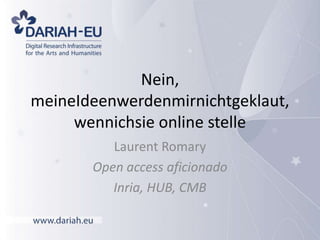
OA in Practice - Key Steps for Sharing Work Online
- 1. Nein, meineIdeenwerdenmirnichtgeklaut, wennichsie online stelle Laurent Romary Open access aficionado Inria, HUB, CMB
- 2. Open access in the practice • Scholarly work is about accessing and disseminating information (and a little thinking in between) • When, where and under which conditions can/should I put my results online? • Are publications and research data any different? • Am I alone?
- 3. Starting with the worst case • Anne Musterfrau has made a beautiful transcription of an 19th century manuscript • She puts it online as an HTML page on her google+ account • She’s now wondering if she did it right… • Well no, she was afraid that the content could be stolen – So she puts the final touch on it
- 4. The ultimate sealing text “All rights reserved. Without limiting the rights under copyright reserved above, no part of this book may be reproduced, stored in or introduced into a retrieval system, or transmitted, in any form or by any means (electronic, mechanical, photocopying, recording or otherwise) without the written permission of both the copyright owner and the author of the book.” Real example taken from a PhD thesis from XX
- 5. Anne could have done better • Authorship – Who is responsible for the work online – E.g. providing feedback • Format – The document can only be read, not re-used – No semantics attached, even if all proper names have been put in italics… • Technical sustainability – No trustful digital setting – What if the google account is being blocked • Re-use instructions – Two ways of doing things wrong • No clear license attached to the document • Is the reader allowed to take up even a paragraph? – Reserving all rights
- 6. Opening up the door for plagiarism? • What to do when you find a book on a shelf? – Plagiarism has always existed… – Plagiarism is easy when the original is not easily available • Plagiarism is just the non-educated standard reuse of scholarly results – Cf. Montaigne and Pascal, and the tradition of medieval sermons – You need to pave the way for proper scholarly re-use • Encouraging virtue rather than fighting vice
- 7. Berlin Declaration (2003) „…free, irrevocable, worldwide, right of access to, and a license to copy, use, distribute, transmit and display the work publicly and to make and distribute derivative works, in any digital medium for any responsible purpose….“
- 8. Primary and secondary representations • Showing the (e.g. TEI) source – Standardized format – Coupled with persistent identifiers – HTML format just there to look pretty • Advantages – Facilitate the creation of secondary objects (other publication formats) – Facilitate the integration within collections of documents – Provides a stable reference for further annotation – Gives an example of existing (“good”) practices
- 9. Acknowledging authorship • A general vision of scholarly work – Context in which a piece of work is produced – Funding and responsibilities • Importance of proper affiliation description – – – – Importance for institutional acknowledgement Bibliometric aspects, reporting, PR, strategic planning Departing from the old printed “address” Electronic affiliation: team/laboratory/institution • Importance of a trusted repository with an authors’ database – E.g. French publication repository HAL
- 10. Licensing • Objective: providing clear guidance on the usage possibilities of the online work • Back to basic: scholarly work – Attribution of any work to its source • Context: Creative commons portfolio – – – – CC0: waiving all rights CC-BY: attribution -NC: non commercial -SA: share-alike (the viral element)
- 11. Comments on options • CC0: putting things in the public domain – Can be important for meta-data (fluidity) – Difficult in some legal systems (“droitd’auteur”) – Contrary to scholarly mechanisms • CC-BY – Authors have to be referenced: importance of a clear guidance on how to cite the work – Not all mechanisms are in place when dealing with complex compounds • -NC –SA – Put constraints on how the work can be further distributed – Difficulties to identify what a commercial usage is – Requires quite bunch of lawers
- 12. What about peer-review? • Peer review is not needed to be used and quoted • Peer-review provides a branding (membership in a scholarly community) • Peer review does not work that well in all cases • What do we want at the end? – Signs of recognition by a scholarly community
- 13. Possible trends to improve scholarly communication • Citation – Identifying them, counting them • Usage – Access; downloads; links • Post-publishing peer review – The Episciences experiment: overlay journals – The blog model: publish - comment • Community participation – Social networks – Online comments
- 14. Publication or research data • Same constraints on digital infrastructures – Indentifying, archiving, retrieving • Same attribution condition – Citing further authorship for edited sources • Same importance of open standards – Referencing, citing, annotating, compiling • Same requirements on acknowledgement – Citation, evaluation (data journals) • Continuum between research data and publication – Blogs are part of this continuum
- 15. Summary what you should do • Accept that being a scholar is being a (digital) public person • Never lock your work in a publisher’s treasure box – And never pay for being publish… • Not be afraid of self-plagiarism (multimedial) • Train assessment/recruiting panels to consider a variety of notoriety signs • Speak to your institution about open access
- 16. Summary what your institution should do • Know some basic elements about scholarly communication • [dream] issue an open access policy – Green, fair gold (no hybrid), encourage new publishing model • Provide guidelines to assesment/recruiting panels about changed induced by digital contexts